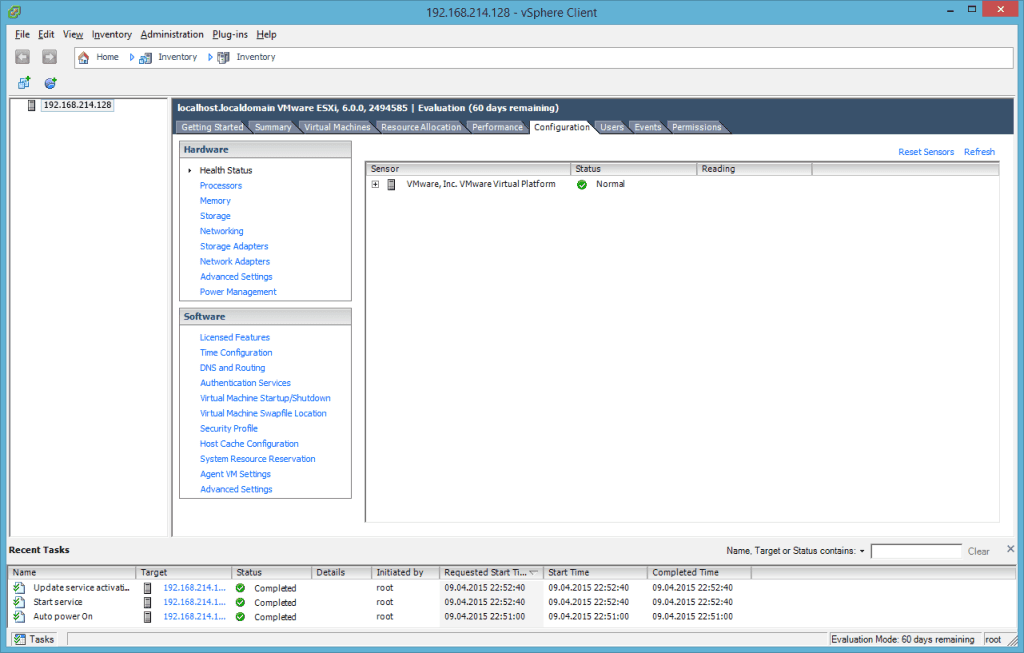
- VMWARE 6.0 NETWORK CONFIGURATION HOW TO
- VMWARE 6.0 NETWORK CONFIGURATION INSTALL
- VMWARE 6.0 NETWORK CONFIGURATION DRIVER
- VMWARE 6.0 NETWORK CONFIGURATION SOFTWARE
VMWARE 6.0 NETWORK CONFIGURATION INSTALL
Take whatever version you want. You can either boot an Android-x86 live system, or install it to the virtual disk.Įdit the VM config File (.vmx) and changed the network adapter type to vlance: Some older versions are available as separate Isos for different devices. All versions can be installed and used in VMware Workstation: The following Android-x86 releases are currently available.
VMWARE 6.0 NETWORK CONFIGURATION HOW TO
This post shows how to install Android in VMware Workstation and how to solve Network Connectivity issues.
VMWARE 6.0 NETWORK CONFIGURATION DRIVER
Driver support is very limited, so there are many problems around with Android VMs that cant access the network. This allows us to install Android in a Virtual Machine with VMware Workstation or ESXi. The output of this command exactky mateches with the Paths that we saw earlier in the vSphere Web Client.When you want to test Android on your PC, Android-x86 might be your solution. Android-x86 is an open source project that has ported Android to x86 platform. You can also verify if multipathing is set correctly by running the below command which will list all the paths on the ESXi host. ~ # esxcli iscsi networkportal add -nic vmk2 -adapter vmhba33īoth the methods will achieve you the same results. ~ # esxcli iscsi networkportal add -nic vmk1 -adapter vmhba33 The final step would be to perform the Network Port Binding. ~ # esxcli iscsi adapter discovery sendtarget add -a 192.168.0.108:3260 -A vmhba33
VMWARE 6.0 NETWORK CONFIGURATION SOFTWARE
Next, we will have to make the add the target IP address for the Software iSCSI Adapter that was created. Once that is done the network configuration will be complete and will match as shown below. ~ # esxcli network ip interface add -p iSCSI2 -i vmk2 ~ # esxcli network ip interface add -p iSCSI1 -i vmk1 The last step would be to create the VMkernel interfaces and associate them with the portgroups we have just created and provide the correct IP addresses. ~ # esxcli network vswitch standard portgroup policy failover set -a vmnic2 -p iSCSI2 ~ # esxcli network vswitch standard portgroup policy failover set -a vmnic1 -p iSCSI1 We will now have to associate vmnic1 to the portgroup iSCSI1 and vmnic2 to iSCSI2 portgroup. ~ # esxcli network vswitch standard policy failover set -a vmnic1,vmnic2 -v vSwitch1 ~ # esxcli network vswitch standard uplink add -u vmnic2 -v vSwitch1 ~ # esxcli network vswitch standard uplink add -u vmnic1 -v vSwitch1 Next, we need to add the uplinks vmnic1 and vmnic2 to the new vSwitch: ~ # esxcli network vswitch standard portgroup add -p iSCSI2 -v vSwitch1 ~ # esxcli network vswitch standard portgroup add -p iSCSI1 -v vSwitch1 Once the switch is created we will create the two new portgroups called iSCSI1 and iSCSI2: ~ # esxcli network vswitch standard add -v vSwitch1 So let us quickly go through the steps required to perform this.Ĭreate a new standard vSwitch called vSwitch1: The steps would remain the same as done from the vSphere Web Client. Configure iSCSI Port Binding using vSphere Web ClientĬonfigure iSCSI Port Binding using ESXCLIĪnother way to perform this activity is through esxcli. With that being said, let us work through by looking at an example so that we are clear with the concepts.

The default iSCSI configuration on the VMware ESXi host creates only one path to each iSCSI target.īefore vSphere 5.0, administrators had to configure iSCSI port binding using the command line. ISCSI Port Binding is used when one needs multiple paths to each iSCSI target.


 0 kommentar(er)
0 kommentar(er)
